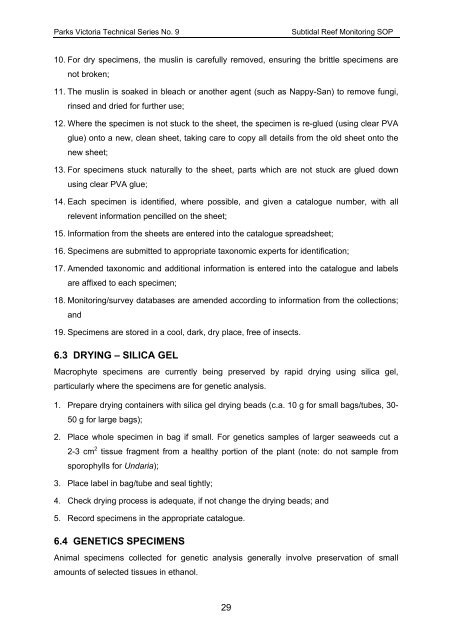Parks Victoria Standard Operating Procedure
Parks Victoria Standard Operating Procedure
Parks Victoria Standard Operating Procedure
- No tags were found...
Create successful ePaper yourself
Turn your PDF publications into a flip-book with our unique Google optimized e-Paper software.
<strong>Parks</strong> <strong>Victoria</strong> Technical Series No. 9Subtidal Reef Monitoring SOP10. For dry specimens, the muslin is carefully removed, ensuring the brittle specimens arenot broken;11. The muslin is soaked in bleach or another agent (such as Nappy-San) to remove fungi,rinsed and dried for further use;12. Where the specimen is not stuck to the sheet, the specimen is re-glued (using clear PVAglue) onto a new, clean sheet, taking care to copy all details from the old sheet onto thenew sheet;13. For specimens stuck naturally to the sheet, parts which are not stuck are glued downusing clear PVA glue;14. Each specimen is identified, where possible, and given a catalogue number, with allrelevent information pencilled on the sheet;15. Information from the sheets are entered into the catalogue spreadsheet;16. Specimens are submitted to appropriate taxonomic experts for identification;17. Amended taxonomic and additional information is entered into the catalogue and labelsare affixed to each specimen;18. Monitoring/survey databases are amended according to information from the collections;and19. Specimens are stored in a cool, dark, dry place, free of insects.6.3 DRYING – SILICA GELMacrophyte specimens are currently being preserved by rapid drying using silica gel,particularly where the specimens are for genetic analysis.1. Prepare drying containers with silica gel drying beads (c.a. 10 g for small bags/tubes, 30-50 g for large bags);2. Place whole specimen in bag if small. For genetics samples of larger seaweeds cut a2-3 cm 2 tissue fragment from a healthy portion of the plant (note: do not sample fromsporophylls for Undaria);3. Place label in bag/tube and seal tightly;4. Check drying process is adequate, if not change the drying beads; and5. Record specimens in the appropriate catalogue.6.4 GENETICS SPECIMENSAnimal specimens collected for genetic analysis generally involve preservation of smallamounts of selected tissues in ethanol.29

















